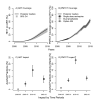Changing Dynamics of HIV Transmission in Côte d'Ivoire: Modeling Who Acquired and Transmitted Infections and Estimating the Impact of Past HIV Interventions (1976-2015)
- PMID: 28471837
- PMCID: PMC5508974
- DOI: 10.1097/QAI.0000000000001434
Changing Dynamics of HIV Transmission in Côte d'Ivoire: Modeling Who Acquired and Transmitted Infections and Estimating the Impact of Past HIV Interventions (1976-2015)
Abstract
Introduction: Understanding the impact of past interventions and how it affected transmission dynamics is key to guiding prevention efforts. We estimated the population-level impact of condom, antiretroviral therapy (ART), and prevention of mother-to-child transmission activities on HIV transmission and the contribution of key risk factors on HIV acquisition and transmission.
Methods: An age-stratified dynamical model of sexual and vertical HIV transmission among the general population, female sex workers (FSW), and men who have sex with men was calibrated to detailed prevalence and intervention data. We estimated the fraction of HIV infections averted by the interventions, and the fraction of incident infections acquired and transmitted by different populations over successive 10-year periods (1976-2015).
Results: Overall, condom use averted 61% (95% credible intervals: 56%-66%) of all adult infections during 1987-2015 mainly because of increased use by FSW (46% of infections averted). In comparison, ART prevented 15% (10%-19%) of adult infections during 2010-2015. As a result, FSW initially (1976-1985) contributed 95% (91%-97%) of all new infections, declining to 19% (11%-27%) during 2005-2015. Older men and clients mixing with non-FSW are currently the highest contributors to transmission. Men who have sex with men contributed ≤4% transmissions throughout. Young women (15-24 years; excluding FSW) do not transmit more infections than they acquired.
Conclusions: Early increases in condom use, mainly by FSW, have substantially reduced HIV transmission. Clients of FSWs and older men have become the main source of transmission, whereas young women remain at increased risk. Strengthening prevention and scaling-up of ART, particularly to FSW and clients of female sex workers, is important.
Conflict of interest statement
Figures



References
-
- Koffi K, Gershy-Damet GM, Peeters M, Soro B, Rey JL, Delaporte E. Rapid spread of HIV infections in Abidjan, Ivory Coast, 1987-1990. Eur J Clin Microbiol Infect Dis. 1992;11(3):271–273. - PubMed
-
- Odehouri K, De Cock KM, Krebs JW, et al. HIV-1 and HIV-2 infection associated with AIDS in Abidjan, Côte d'Ivoire. AIDS. 1989;3(8):509–512. - PubMed
-
- Denis F, Barin F, Gershy-Damet G, et al. Prevalence of human T-lymphotropic retroviruses type III (HIV) and type IV in Ivory Coast. Lancet. 1987;1(8530):408–411. - PubMed
-
- De Cock KM, Porter A, Odehouri K, et al. Rapid emergence of AIDS in Abidjan, Ivory Coast. Lancet. 1989;2(8660):408–411. - PubMed
-
- Amat-Roze J. Sexually Transmitted Diseases and HIV/AIDS in Côte d'Ivoire. In: Setel P, Lewis M, Lyons M, editors. Histories of Sexually Transmitted Diseases and HIV/AIDS in Sub-Saharan Africa. Westport, CT: Greenwood Publishing Group; 1999. pp. 43–64.
MeSH terms
Substances
Grants and funding
LinkOut - more resources
Full Text Sources
Other Literature Sources
Medical
Research Materials
Miscellaneous

